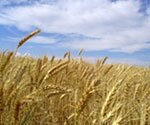Agriculture
 High and dry on the Columbia Plateau, Sherman County’s most important crop is winter wheat. Of the county's 531,200 acres, 304,138 are tillable. Farms average 3,500 acres and the average yield is 42 bushels per acre.
High and dry on the Columbia Plateau, Sherman County’s most important crop is winter wheat. Of the county's 531,200 acres, 304,138 are tillable. Farms average 3,500 acres and the average yield is 42 bushels per acre.
Soft white wheat is most common and is used for pocket or flat breads, crackers, cookies, cake, pastries and noodles.
Sherman County lies in the immediate “rain shadow” east of the Cascade Mountain Range. The prevailing west winds blow moisture-laden clouds up over the mountains, forcing them to release their moisture and leaving them dry as they hit the lower elevation of the county’s rolling hills. Too dry to annually crop on 11 inches of annual precipitation, farmers employ the summer fallow system of farming to permit dry land wheat and barley production. Half the farm is typically laid out of production (fallow) allowing it to store moisture for the next crop. Employing conservation practices allows the land to capture and store about 42% of the moisture during the fallow period so the next crop is raised using two years of moisture. Very little farmland is irrigated.
Soft white winter wheat dominates the scene with about 110,000 acres planted each fall and harvested the following July and August. Spring barley and spring wheat may be planted in the spring and are used primarily as a disease and weed management tool. Farmers continue to adopt precision farming practices and direct seeding technology. Wheat accounted for 83% of the farm gate value in Sherman County in 2005.
Grain is trucked from the harvest field to cooperative elevators and to barge and rail shipping facilities on the Columbia River at  Biggs for transport to Portland. The price the farmer receives is the Portland price minus the transportation to Portland and related storage and handling fees. Supplementary farm income comes from beef cattle which graze the 223,000 acres of native grasses on early summer rangelands and the wheat stubble in the fall. Some farm families have small numbers of horses, hogs, goats and sheep. Other crops include alfalfa for hay, plus a developing farm industry of grapes and sweet cherries and minor specialty crops such as garlic, mint, sunflowers, onion seed, carrot seed, peas and oilseeds. Fee hunting and guided fishing and hunting are growing enterprises.
Biggs for transport to Portland. The price the farmer receives is the Portland price minus the transportation to Portland and related storage and handling fees. Supplementary farm income comes from beef cattle which graze the 223,000 acres of native grasses on early summer rangelands and the wheat stubble in the fall. Some farm families have small numbers of horses, hogs, goats and sheep. Other crops include alfalfa for hay, plus a developing farm industry of grapes and sweet cherries and minor specialty crops such as garlic, mint, sunflowers, onion seed, carrot seed, peas and oilseeds. Fee hunting and guided fishing and hunting are growing enterprises.
Government conservation programs, such as the Conservation Reserve Program (CRP), allow the establishment 76,000 acres which cannot be grazed or harvested. These programs bring an additional income to farmers.
Wind farms provide additional income for some farm families in the northeast section of the county as the county lies on the cusp between the hot dry land desert lands to the east and the cool moist intermountain valley and ocean to the west.
2005 Sherman County Farm Gate Values
| Month | Average |
|---|---|
| All wheat | $21,508,000 |
| All cattle | $2,200,000 |
| All barley | $553,000 |
| All other crops & livestock | $1,799,000 |
| Total | $26,060,000 |
~ Sandy Macnab, ShermanCounty Extension, Oregon State University








